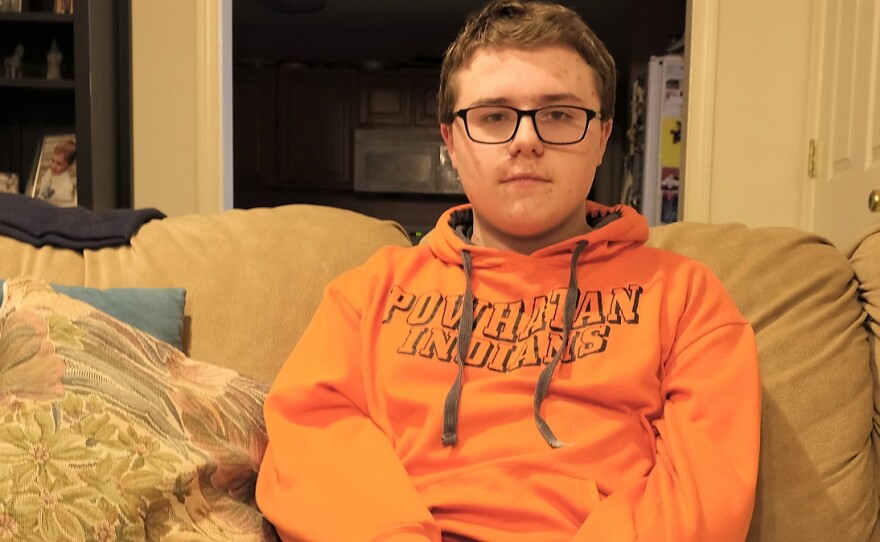After years of advocacy from Virginia youth, parents and legal experts, the state is in the process of finalizing regulations to limit the use of restraint and seclusion in public schools.
One central Virginia student has been particularly vocal about the process. Alex Campbell is 13 years old. He’s an 8th grader at Powhatan Middle School. His hobby: politics. More specifically, disability rights. He was diagnosed with autism at 3 ½ years old. He now takes several high school level classes including Spanish and Algebra.
But in elementary school, things weren’t going so smoothly. In 2012, he was enrolled in Dominion Academy, a private day school in Richmond for students with disabilities. Alex’s dad Sean Campbell remembers a room he saw on a tour, but didn’t think much of it at the time.
“It was a quiet place where kids could go in and recenter themselves and then get back into the class,” Campbell said. “That's how it was presented.”
But Alex had a different experience with that room. He compared it to a large bathroom, about 8-by-10 feet in size. Alex says his principal routinely placed him there alone for acting out over something as minor as tearing paper. A crisis log from the school details six times Alex was secluded in less than two weeks for 10 to 30 minutes each. Behavior described included standing in a chair, yelling and hitting staff members.
The staff member who Alex says put him there is no longer with the school. Joshua Lutz, who replaced him, told WCVE they no longer seclude students in what was called the crisis room. But he wouldn’t comment on how widely the practice of restraint is used, and would not share the data with WCVE. Lutz said any instances of restraint would be reported to the student’s LEA, or local educational agency. Alex’s LEA: Powhatan County Public Schools.
Alex Campbell (far left) is pictured outside his Powhatan County home with father Sean, mother Kelly and brother Jack. (Photo: Megan Pauly/WCVE)
WCVE has requested information about how the district and several others in central Virginia are currently using restraint and seclusion. The U.S. Department of Education’s Office of Civil Rights required public school districts to start self-reporting their use of restraint and seclusion in 2009. Colleen Miller with the Disability Law Center of Virginia says she suspects that data is incomplete.
“Where we have seen reporting requirements, we think there's pretty poor compliance with those reporting requirements,” Miller said. “So it's really hard to get a grip on how widespread the use is.”
A recent WAMU investigation uncovered hundreds of unreported cases of seclusion and restraint in Fairfax County Public Schools. Powhatan and Hanover County Public Schools didn’t report any cases of seclusion or restraint to the federal government in 2015, the most recent year for which data is available.
But some central Virginia districts did report numerous instances of both restraint and seclusion in 2015. For example, Chesterfield County alone reported secluding students a total of 80 times, and restraining students a total of 29 times. There's also an ongoing civil rights investigation from 2016 regarding these issues, according to the U.S. Department of Education.
In 2015, Henrico reported 6 instances of seclusion, and 21 instances of restraint. Richmond reported zero instances of seclusion, and 41 instances of restraint. When broken down by race, gender and disability the numbers reported vary.
“It should only really be used when there is a serious danger to the child or to others in the environment.”- Colleen Miller, Disability Law Center of Virginia
The federal government defines seclusion as the involuntary isolation and confinement of a student. They define two types of restraint. The first: physically immobilizing a student from moving freely. The second: mechanical restraint, using a device or equipment to restrict movement.
Virginia passed a law in 2015 requiring the state board of education to develop regulations limiting the use of the practices in public schools.
“It should only really be used when there is a serious danger to the child or to others in the environment,” Miller said.
But Miller and others like Rachael Deane with the Legal Aid Justice Center, say they still have concerns about some of the language in the regulations, and what’s left out.
“We are concerned that a student -- even if they're not physically prevented from leaving -- if they don't realize they're free to leave, then there's still a seclusion type situation going on,” Deane said.
Deane is also concerned that the regulations don't explicitly prohibit the use of prone restraint, restraint by placing a student face down.
"It is inherently dangerous and has even caused death," Deane said.
The public comment period for the proposed regulations is open until April 19. Meanwhile, families are continuing to speak out against restraint and seclusion of students -- including at a protest in Fairfax County Tuesday.
Families like the Campbells are optimistic the state will soon start collecting and reporting more complete -- and more detailed -- data. They want to see data about the use of the practices in private schools too. A spokesperson for Virginia’s Department of Education said that even though regulations limiting the use of seclusion and restraint in private schools took effect in 2015, the department hasn't started collecting or reporting that data. Intead, they're waiting until the regulations on public schools take effect.




